If you work in the human services industry, regardless of who you serve, you know one thing for sure: change is constant.
Funding sources shift. Community needs evolve. Regulations get rewritten. And staffing challenges? They’re always top of mind. For organizations tasked with meeting essential human needs, that kind of unpredictability can feel overwhelming.
That’s where scenario planning comes in. Unlike traditional strategic planning, which assumes a relatively stable path forward, scenario planning helps leaders ask, “what if?” and explore how their organization would respond. It’s less about predicting the future and more about being ready for it.
Why It Matters
Here’s why scenario planning is so powerful in the human services industry:
- Funding is never guaranteed. A government budget change or grant expiration can impact your programs overnight. Scenario planning helps you prepare for both shortfalls and unexpected windfalls.
- Community needs can shift fast. Think about how the pandemic reshaped demand for mental health support and family services. With scenario planning, you can model how you’d respond if demand suddenly spikes—or drops off.
- Your workforce is your backbone. Recruiting and retaining qualified staff is tough in today’s environment. Planning ahead for staffing shortages (or opportunities to grow) helps you avoid scrambling.
- Policies and regulations change often. Medicaid rules, reimbursement structures, and compliance requirements can swing in different directions. Scenario planning gives you a way to respond quickly without losing focus on your mission.
How It Works
Scenario planning is essentially a structured way of asking: What might happen, and how would we respond? Here’s a simple framework:
- Spot your key drivers of change. For most human service organizations, that means funding, workforce, community demand, and policy.
- Sketch out a few “what if” stories. For example: “What if we lose 20% of our funding?” or “What if demand for addiction treatment services doubles in two years?”
- Test your strategies. Would your current programs and staffing levels hold up? Where would you be vulnerable?
- Build flexible plans. Instead of a rigid playbook, scenario planning leaves you with adaptable strategies and a stronger sense of where you’ll need to pivot.
What This Looks Like in Practice
- Children & Family Services might explore what happens if caseloads climb during an economic downturn—or how to respond if state funding shifts to a new model.
- Community Service Organizations could plan for changing demographics by preparing to expand language access services or job training programs.
- Developmental Disabilities Services might test scenarios around Medicaid reimbursement changes or workforce shortages.
- Mental Health & Addiction Services can map out how to meet rising demand if a community mental health crisis intensifies, or if insurance coverage rules suddenly change.
From Planning to Preparedness
Here’s the key: scenario planning isn’t about being able to predict what’s coming. It’s about making sure you’re not caught off guard when change does arrive.
When boards, leadership teams, and staff go through the process together, organizations build a culture of adaptability. And that culture is what allows you to keep your mission strong, even in the middle of uncertainty.
For human service organizations, scenario planning is a safeguard for the people and communities you serve. The better prepared you are for the unknown, the stronger your impact will be.
If you need further guidance or have any questions on this topic, we are here to help. Please do not hesitate to reach out to discuss your specific situation.
This material has been prepared for general, informational purposes only and is not intended to provide, and should not be relied on for tax, legal or accounting advice. Should you require any such advice, please contact us directly. The information contained herein does not create, and your review or use of the information does not constitute, an accountant-client relationship.




